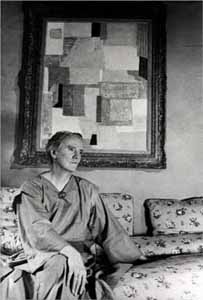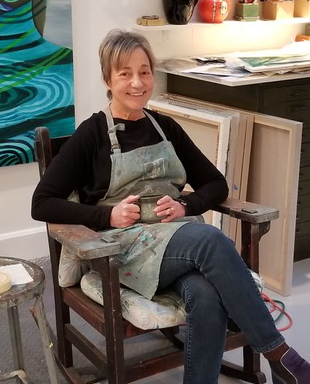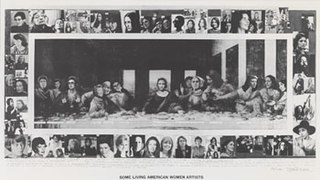
Lenore Tawney was an American artist working in fiber art, collage, assemblage, and drawing. She is considered to be a groundbreaking artist for the elevation of craft processes to fine art status, two communities which were previously mutually exclusive. Tawney was born and raised in an Irish-American family in Lorain, Ohio near Cleveland and later moved to Chicago to start her career. In the 1940s and 50s, she studied art at several different institutions and perfected her craft as a weaver. In 1957, she moved to New York where she maintained a highly successful career into the 1960's. In the 1970s Tawney focused increasingly on her spirituality, but continued to make work until her death.
The Woman's Building was a non-profit arts and education center located in Los Angeles, California. The Woman's Building focused on feminist art and served as a venue for the women's movement and was spearheaded by artist Judy Chicago, graphic designer Sheila Levrant de Bretteville and art historian Arlene Raven. The center was open from 1973 until 1991. During its existence, the Los Angeles Times called the Woman's Building a "feminist mecca."

A.I.R. Gallery is the first all female artists cooperative gallery in the United States. It was founded in 1972 with the objective of providing a professional and permanent exhibition space for women artists during a time in which the works shown at commercial galleries in New York City were almost exclusively by male artists. A.I.R. is a not-for-profit, self-underwritten arts organization, with a board of directors made up of its New York based artists. The gallery was originally located in SoHo at 97 Wooster Street, and was located on 111 Front Street in the DUMBO neighborhood of Brooklyn until 2015. In May 2015, A.I.R. Gallery moved to its current location at 155 Plymouth St, Brooklyn, NY 11201.

James T. Nutt is an American artist who was a founding member of the Chicago surrealist art movement known as the Chicago Imagists, or the Hairy Who. Though his work is inspired by the same pop culture that inspired Pop Art, journalist Web Behrens says Nutt's "paintings, particularly his later works, are more accomplished than those of the more celebrated Andy Warhol and Roy Lichtenstein." According to Museum of Contemporary Art curator Lynne Warren, Nutt is "the premier artist of his generation". Nutt attended the School of the Art Institute of Chicago, in Chicago, Illinois. He is married to fellow-artist and Hairy Who member Gladys Nilsson.

Anne Ryan (1889–1954) was an American Abstract Expressionist artist associated with the New York School. Her first contact with the New York City avant-garde came in 1941 when she joined the Atelier 17, a famous printmaking workshop that the British artist Stanley William Hayter had established in Paris in the 1930s and then brought to New York when France fell to the Nazis. The great turning point in Ryan's development occurred after the war, in 1948. She was 57 years old when she saw the collages of Kurt Schwitters at the Rose Fried Gallery, in New York City, in 1948. She right away dedicated herself to this newly discovered medium. Since Anne Ryan was a poet, according to Deborah Solomon, in Kurt Schwitters’s collages “she recognized the visual equivalent of her sonnets – discrete images packed together in an extremely compressed space.” When six years later Ryan died, her work in this medium numbered over 400 pieces.
Gladys M. Nilsson is an American artist, and one of the original Hairy Who Chicago Imagists, a group of representational artists active during the 1960s and 1970s. She is married to fellow-artist and Hairy Who member Jim Nutt.
Hollis Sigler was an American artist. She received several Arts Lifetime Achievement awards as both an artist and an educator, including the Distinguished Artist Award for Lifetime Achievement from the College Art Association in 2001.

Gertrude Abercrombie was an American painter based in Chicago. Called "the queen of the bohemian artists", Abercrombie was involved in the Chicago jazz scene and was friends with musicians such as Dizzy Gillespie, Charlie Parker, and Sarah Vaughan, whose music inspired her own creative work.
Vera Klement was an American artist, and Professor Emerita at the University of Chicago. She was a 1981 Guggenheim Fellow.
Women's Art Resources of Minnesota (WARM) is a women's art organization based in the U.S. state of Minnesota. It was founded in 1976 as Women's Art Registry of Minnesota, a feminist artist collective. The organization ran the influential WARM Gallery in downtown Minneapolis from 1976 to 1991.
West-East Bag (WEB) was an international women artists network active from 1971 to 1973.

Richard Wetzel is an American artist. He is best known for his oil paintings but also has exhibited collages and sculpture. In 1969 and 1970, Wetzel exhibited with the Chicago Imagists, a grouping of Chicago artists who were ascendant in the late 1960s and early 1970s.
Susan Michod is an American feminist painter who has been at the forefront of the Pattern and Decoration movement since 1969. Her work "consists of monumental paintings [which are] thickly painted, torn, collaged, spattered, sponged, sprinkled with glitter and infused with a spirit of love of nature and art," the art critic Sue Taylor has written.
Bonnie Harris was an American artist.

Don Baum was an American curator, artist and educator, most known as a key impresario and promoter of the Chicago Imagists, a group of artists that had an enduring impact on American art in the later twentieth century. Described by the Museum of Contemporary Art, Chicago (MCA) as "an indispensable curator of the Chicago school," Baum was known for lively and irreverent exhibitions that offered fresh perspectives combining elements of Surrealism and Pop and that broke down barriers between schooled and untrained, or so-called outsider artists. From 1956 to 1972, Baum was exhibitions director at Chicago's Hyde Park Art Center. It was there, in the 1960s, that he became involved with a group of young artists he exhibited as "Hairy Who" that later expanded to become the Chicago Imagists. That group included Ed Paschke, Jim Nutt, Roger Brown, Gladys Nilsson, and Karl Wirsum. Baum mounted two major shows at the MCA that featured the emerging artists in their first museum exhibitions: "Don Baum Sez: 'Chicago Needs Famous Artists'" (1969) and "Made in Chicago" (1973), which shaped a vision of Chicago's art world as a place of meticulous craftsmanship and vernacular inspiration.

Barbara Grad is an American artist and educator, known for abstract, fractured landscape paintings, which combine organic and geometric forms, colliding planes and patterns, and multiple perspectives. Her work's themes include the instability of experience, the ephemerality of nature, and the complexity of navigating cultural environments in flux. While best known as a painter, Grad also produces drawings, prints, mixed-media works and artist books. She has exhibited in venues including the Art Institute of Chicago, Kemper Museum of Contemporary Art, Danforth Art, Rose Art Museum, Indianapolis Museum of Art and A.I.R., and been reviewed in publications, including Artforum, Arts Magazine and ARTnews. Grad co-founded Artemisia Gallery, one the country's first women-artist collectives, in Chicago in 1973. She has been an educator for over four decades, most notably at the Massachusetts College of Art and Design. Grad has been based in the Boston area since 1987.
Artemisia Gallery was an alternative exhibition space in Chicago, Illinois, United States, that operated from 1973 until its closure in 2003.
Joan Livingstone is an American contemporary artist, educator, curator, and author based in Chicago. She creates sculptural objects, installations, prints, and collages that reference the human body and bodily experience.

Sue Hettmansperger is an American artist known for paintings and collages that work across the spectrum of modernist abstraction and representational imagery. Her work explores the interconnectedness of human, botanical and inorganic systems, scientific concepts and ecological concerns. She has been awarded Guggenheim and National Endowment for the Arts fellowships and her work belongs to the public collections of the Metropolitan Museum of Art, Art Institute of Chicago and Des Moines Art Center, among other institutions. She lives and works in Iowa City and is Professor Emerita of Art at the University of Iowa.

Some Living American Women Artists, also referred to as Some Living American Women Artists/Last Supper, is a collage by American artist Mary Beth Edelson created during the second wave feminist movement. The central portion is an image based on Leonardo da Vinci’s 15th-century mural Last Supper. Edelson replaced the faces of Christ's disciples with cut-out photographs of American women artists. She surrounded the central image with additional photographs of American women artists. The work is in the collection of the Museum of Modern Art.










